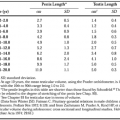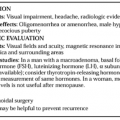SURGICAL APPROACH TO THYROID CANCER
PAPILLARY CARCINOMA
The surgical treatment of papillary carcinoma (see Chap. 40) is best divided into two categories, based on the clinical characteristics and virulence of these lesions.
MINIMAL PAPILLARY CARCINOMA
The term minimal papillary carcinoma refers to a small papillary tumor, usually <5 mm in diameter, that demonstrates no local invasiveness through the thyroid capsule, is not associated with lymph node metastases, and is often found in a young person as an occult lesion when thyroidectomy has been performed for another benign condition.13 In such instances, lobectomy is sufficient and repeated surgeries are unnecessary; thyroid hormone is given to suppress serum thyroid-stimulating hormone (TSH) levels, and the patient is followed at regular intervals.
STANDARD TREATMENT FOR MOST PAPILLARY CARCINOMAS
Most papillary carcinomas are neither minimal nor occult. Papillary cancers are known to be microscopically multicentric in up to 80% of cases, occasionally to invade locally into the trahea or esophagus,14 to metastasize commonly to lymph nodes and later to the lungs and other tissues, and to recur clinically in the other thyroid lobe in 7% to 18% of patients if treated by only thyroid lobectomy.15,16
In the United States, ˜1200 deaths occur each year from thyroid cancer and half of these deaths occur in patients with anaplastic thyroid carcinoma. Importantly, most patients with papillary thyroid cancer have a very good prognosis, particularly those who are young. Although the best treatment for most papillary cancers is near total or total thyroidectomy, with appropriate central and lateral neck dissections when nodes are involved, the surgeon with limited experience should not perform total thyroidectomy unless capable of achieving a low incidence of recurrent laryngeal nerve injuries and permanent hypoparathyroidism. Otherwise, referral of these patients to a major medical center where such expertise is available may be advisable. Often, patients are treated with radioactive iodine postoperatively17 (see Chap. 40). External irradiation and chemotherapy17 are sometimes used for those special cases of severe, extensive disease that do not accumulate radioiodine.18 In some studies,19 patients receiving total or near-total thyroidectomy with radioiodine therapy for papillary cancers of 1 cm or larger had decreased mortality and recurrence of disease compared with those receiving lesser operations and no radioactive iodine therapy.
Studies have attempted to predict the potential aggressiveness of a given papillary carcinoma by determination of nuclear DNA measurement20 as well as by formulations of a set of risk factors, including the age of the patient, the size of the tumor, presence or absence of local invasion or distant metastases, the tumor grade, and whether or not all tumor could be resected.16,21,22 Clearly, young patients with small tumors that can be totally resected and that exhibit no local invasion or distant metastases have an excellent prognosis (approximately a 2% mortality from their papillary cancer). Older age, larger tumor size, local tumor invasiveness, presence of distant metastases, and nonresectable tumor are factors that portend a much greater cancer mortality. Approximately 80% of all papillary cancers fall in the low-risk category by these criteria, but 20% are much more aggressive.
Stay updated, free articles. Join our Telegram channel

Full access? Get Clinical Tree






